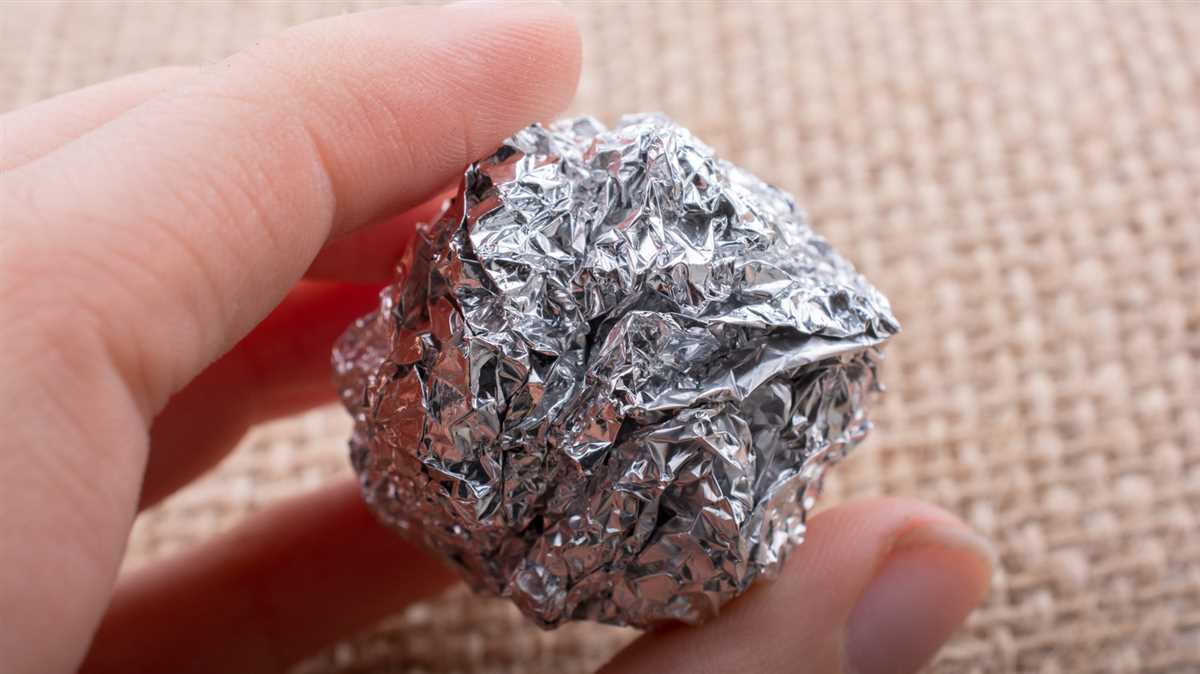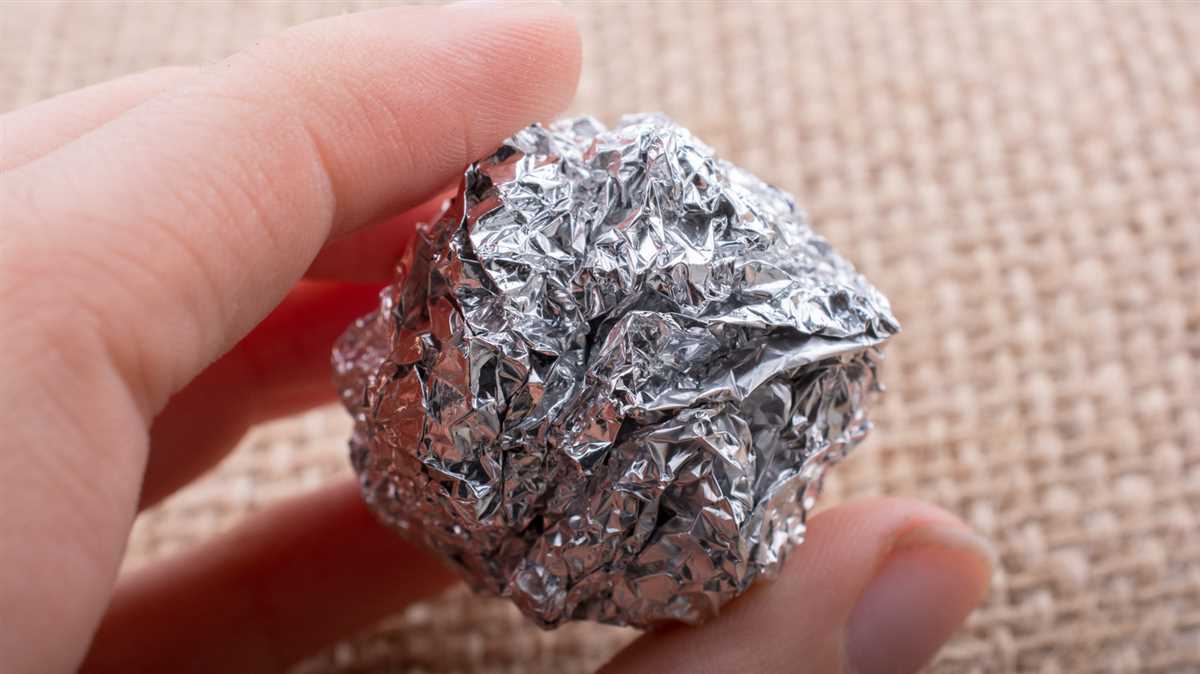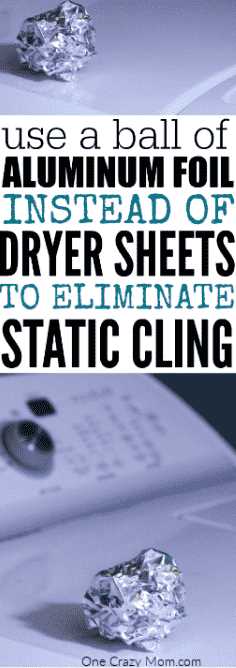




Static cling is a common problem when drying clothes, especially during the winter months. The build-up of static electricity can lead to clothes sticking together and causing frustration for anyone trying to fold and organize laundry. One popular solution that has been suggested is using aluminium foil in the dryer to reduce static. But does this method really work? In this expert guide, we will explore the use of aluminium foil in the dryer and determine if it is an effective solution to combat static cling.
Aluminium foil is a thin metal sheet that is commonly used in cooking and baking to distribute heat evenly. It is also known for its ability to conduct electricity. The idea behind using aluminium foil in the dryer is that it will help to dissipate any static electricity that builds up during the drying process. This, in turn, should reduce or eliminate the static cling on clothes.
Proponents of using aluminium foil in the dryer claim that all you need to do is crumple up a sheet of foil and toss it in with your clothes. As the dryer heats up, the foil will discharge any static electricity and prevent the clothes from sticking together. Sounds simple enough, but does it actually work?
According to experts, while aluminium foil does have the ability to conduct electricity, it is unlikely to significantly reduce static cling in the dryer. The main reason for this is that the amount of static electricity generated in the dryer is relatively small, and the foil may not be able to effectively dissipate it. Additionally, the foil can become damaged or torn during the drying process, which could potentially cause problems in the dryer.
Can You Use Aluminium Foil in the Dryer?

Aluminium foil is a common household item that can be found in most kitchens. It has many uses, from wrapping food for cooking to lining baking sheets. But can you use aluminium foil in the dryer to reduce static? Let’s find out.
What causes static in the dryer?
Static electricity is created when different materials rub against each other. In the dryer, this often happens when clothes rub against the sides of the drum or each other. This friction creates an imbalance of electric charges, resulting in static cling.
Does aluminium foil reduce static in the dryer?
Aluminium foil can help reduce static in the dryer, but it is not the most effective method. While foil does conduct electricity, it is not as effective as using dryer sheets or fabric softeners specifically designed to eliminate static cling.
How to use aluminium foil in the dryer
If you want to give aluminium foil a try in your dryer, here’s how to do it:
- Crumple a sheet of aluminium foil into a ball.
- Toss the foil ball into the dryer with your wet clothes.
- Run the dryer as you normally would.
Other methods to reduce static in the dryer
If aluminium foil doesn’t work for you, there are other methods you can try to reduce static in the dryer:
- Use dryer sheets: Dryer sheets are specifically designed to eliminate static cling. Just toss one or two sheets into the dryer with your clothes.
- Try fabric softener: Adding fabric softener to your laundry can also help reduce static. Follow the instructions on the package for the appropriate amount to use.
- Remove clothes before they are completely dry: Static is more likely to occur when clothes are over-dried. Take your clothes out of the dryer slightly damp to reduce static cling.
Conclusion
While aluminium foil can help reduce static in the dryer, it is not the most effective method. If you’re struggling with static cling, using dryer sheets or fabric softeners specifically designed to eliminate static is a better option. However, if you’re in a pinch, aluminium foil can provide a temporary solution. Remember to crumple the foil into a ball before tossing it into the dryer, and experiment with other methods to find the one that works best for you.
Reduce Static: Expert Guide
Static electricity is a common annoyance, particularly during the dry winter months. Fortunately, there are several effective methods for reducing static in your clothes and household items. In this expert guide, we will explore different techniques that can help you eliminate static and enjoy a static-free environment.
1. Use Dryer Sheets

Dryer sheets contain a thin layer of fabric softener that helps to reduce static electricity in your clothes. Simply toss a dryer sheet into the dryer with your laundry, and it will work to prevent static from building up.
2. Add Vinegar to the Rinse Cycle

Adding a small amount of vinegar to the rinse cycle of your washing machine can help reduce static. The acidic properties of vinegar neutralize any static charge, leaving your clothes static-free.
3. Use Static Guard Spray
Static Guard spray is a specially formulated product that helps to eliminate static cling. Simply spray it on your clothes before wearing them, and it will create a protective barrier against static electricity.
4. Dampen Your Clothes
If you notice static on your clothes before wearing them, try lightly dampening them with water using a spray bottle. The moisture helps to neutralize static charges and reduce static cling.
5. Avoid Over-Drying
Over-drying your clothes in the dryer can contribute to static electricity. To prevent this, remove your clothes from the dryer while they are still slightly damp. This will help to retain moisture in the fabric and reduce static.
6. Moisturize Your Skin
Dry skin can generate more static electricity, leading to static cling. Keep your skin moisturized with lotion to help minimize static buildup.
7. Use Aluminium Foil in the Dryer
Placing a crumpled ball of aluminium foil in the dryer can help reduce static. The foil acts as a conductor, allowing the static electricity to discharge onto it instead of building up in your clothes.
By following these expert tips, you can effectively reduce static electricity in your clothes and enjoy a static-free environment. Experiment with different methods to find the one that works best for you and say goodbye to static cling!
Benefits of Using Aluminium Foil in the Dryer
- Reduces Static: One of the main benefits of using aluminium foil in the dryer is that it helps reduce static cling. The foil discharges static electricity that builds up during the drying process, preventing clothes from sticking together and creating static.
- Softens Clothes: Aluminium foil can also help to soften clothes in the dryer. As the clothes toss and tumble, the foil crinkles and creates a gentle friction, which can help to loosen fibers and make clothes feel softer to the touch.
- Shortens Drying Time: Another advantage of using aluminium foil in the dryer is that it can help to shorten drying time. The foil acts as a heat conductor, reflecting and distributing heat more efficiently. This can result in faster drying, saving both time and energy.
- Cost-Effective: Using aluminium foil in the dryer is a cost-effective alternative to commercial dryer sheets or fabric softeners. Foil is readily available, inexpensive, and can be reused multiple times before needing to be replaced.
- Environmentally-Friendly: Switching to aluminium foil in the dryer can also be a greener choice. Unlike many traditional dryer sheets and fabric softeners, which may contain chemicals and synthetic fragrances, foil is a natural and non-toxic option.
- Easy to Use: Using aluminium foil in the dryer is incredibly simple. Just crinkle a sheet of foil into a ball and toss it into the dryer with your clothes. It requires no special instructions or additional steps.
In conclusion, using aluminium foil in the dryer offers several benefits. It reduces static cling, softens clothes, shortens drying time, is cost-effective, environmentally-friendly, and easy to use. Consider giving it a try to experience these advantages for yourself!
Step-by-step Guide to Using Aluminium Foil in the Dryer
Step 1: Gather the necessary materials
Before you can begin using aluminium foil in the dryer, you will need to gather a few materials:
- Aluminium foil
- Clothes that need to be dried
Step 2: Cut the aluminium foil
Take a sheet of aluminium foil and cut it into small squares or balls. These should be around 2-3 inches in size.
Step 3: Add the aluminium foil to the dryer
Once you have cut the aluminium foil into small squares or balls, add them to the dryer along with the clothes that need to be dried. Make sure to distribute the foil evenly among the clothes.
Step 4: Run the dryer as usual
Start the dryer and run it as you normally would. The heat from the dryer, combined with the movement of the clothes, will cause the aluminium foil to create static electricity, which can help reduce static cling.
Step 5: Remove the clothes from the dryer

Once the drying cycle is complete, remove the clothes from the dryer. You should notice a decrease in static cling, thanks to the aluminium foil.
Step 6: Dispose of the aluminium foil
After you have removed the clothes from the dryer, dispose of the aluminium foil. You can throw it away with your regular household waste.
Step 7: Repeat as necessary
If you find that there is still some static cling in your clothes, you can repeat the process with a new sheet of aluminium foil. Experiment with different sizes or shapes of foil to find the best method for reducing static in your dryer.
Using aluminium foil in the dryer can be an effective way to reduce static cling in your clothes. Follow these steps to ensure proper usage and enjoy static-free, fresh-smelling laundry.
Important Safety Tips when Using Aluminium Foil in the Dryer
While using aluminium foil in the dryer can be a convenient way to reduce static, it is important to follow some safety tips to ensure the safety of yourself and your appliances:
- Use only high-quality aluminium foil: Make sure to choose a heavy-duty aluminium foil that is designed for use in high heat environments. Thin or low-quality foil may not withstand the heat in the dryer and can cause issues.
- Do not overload the dryer: Ensure that you do not pack the dryer with too many clothes or items. Overloading the dryer can cause the foil to come into contact with the heating elements or other sensitive parts, increasing the risk of fire.
- Avoid crumpling the foil: When placing aluminium foil in the dryer, try to keep it as flat as possible. Crumpling the foil can create hotspots and increase the risk of fire.
- Do not use foil with damaged or exposed edges: Inspect the foil before using it in the dryer and discard any foil that has sharp or exposed edges. This can prevent potential damage to the clothes or the machine.
- Avoid contact with other objects: Ensure that the foil does not come into contact with other items in the dryer, such as zippers, buttons, or metal embellishments. These can cause sparks or damage the foil, leading to a potential fire hazard.
- Do not leave the dryer unattended: When using aluminium foil in the dryer, it is important to monitor the drying process and not leave the appliance unattended. This allows you to quickly address any issues that may arise.
- Follow the manufacturer’s instructions: Always consult your dryer’s user manual for any specific guidelines or warnings regarding the use of aluminium foil. Different dryer models may have different requirements or limitations.
By following these safety tips, you can safely use aluminium foil in the dryer and benefit from its static-reducing properties.
Alternatives to Using Aluminium Foil in the Dryer
While using aluminium foil in the dryer can be an effective method to reduce static, some people may have concerns about its safety and potential damage it could cause to the dryer. If you are looking for alternatives to using aluminium foil in the dryer, here are a few options to consider:
1. Wool Dryer Balls

Wool dryer balls are a popular alternative to using aluminium foil in the dryer. These balls are made from natural wool fibers and work by creating space between your laundry items, allowing for better airflow and reducing static. Additionally, they can help to reduce drying time and soften your clothes without the use of chemical fabric softeners.
2. Dryer Sheets
Dryer sheets are another common alternative to using aluminium foil in the dryer. These sheets contain a thin layer of fabric softener or chemicals that help to reduce static and make your clothes smell fresh. Simply toss a dryer sheet into the dryer with your laundry and enjoy the benefits of reduced static and a pleasant scent.
3. Vinegar or Baking Soda
If you prefer a more natural approach, you can try adding vinegar or baking soda to your laundry routine. Vinegar, when used as a fabric softener, can help to eliminate static and soften clothes. Simply add half a cup of vinegar to your rinse cycle or use an empty fabric softener dispenser ball. Baking soda, on the other hand, can act as a natural deodorizer and can help to reduce static when added directly to your laundry load.
4. Increase Humidity
Dry air can often contribute to static electricity. By increasing the humidity in your home, you can help to eliminate static in your laundry. You can use a humidifier, hang damp towels in your laundry area, or even place a small dish of water in the dryer while it’s running to increase moisture and reduce static.
5. Line Drying
One of the most effective ways to eliminate static in your laundry is by line drying your clothes. When you hang your clothes to dry outside, they are naturally exposed to fresh air and humidity, which helps to prevent static from occurring. This method is not only effective for reducing static, but it also saves energy and is environmentally friendly.
Conclusion
While aluminium foil can be a convenient and effective method for reducing static in the dryer, there are several alternatives available. Whether you prefer wool dryer balls, dryer sheets, natural additives like vinegar and baking soda, or simply line drying your clothes, you have various options to choose from. Consider your preferences, environmental concerns, and the specific needs of your laundry when deciding which alternative to use. Everyone’s laundry routine is unique, so experiment with different methods to find the one that works best for you.
FAQ
Can I put aluminium foil in the dryer to reduce static?
Yes, you can use aluminium foil in the dryer to reduce static. It is a simple and effective method to eliminate static electricity from your clothes.
How does aluminium foil reduce static in the dryer?
Aluminium foil works as a conductor and discharges static electricity in the dryer. When you place the foil in the dryer, it absorbs the electrical charge on your clothes, preventing static build-up.
Do I need to crumple the aluminium foil before putting it in the dryer?
Yes, you should crumple the aluminium foil before putting it in the dryer. By crumpling the foil, you create more surface area for it to come in contact with the clothes, increasing its effectiveness in reducing static.
Are there any risks or dangers in using aluminium foil in the dryer?
No, using aluminium foil in the dryer is safe and poses no risks or dangers. However, make sure you are using regular aluminium foil and not foil with a non-stick coating, as the coating may transfer onto your clothes and cause stains.
Can I reuse the same piece of aluminium foil in multiple dryer cycles?
Yes, you can reuse the same piece of aluminium foil in multiple dryer cycles. Just make sure to crumple it again before each use to maximize its effectiveness in reducing static.
Can I use aluminium foil in the dryer to reduce static?
Yes, you can use aluminium foil in the dryer to reduce static. Simply crumple up a sheet of aluminium foil into a ball and toss it into the dryer with your clothes. The foil will help to eliminate static cling by absorbing the electrical charges that cause it. It’s a simple and inexpensive solution to reducing static in the dryer.
How does aluminium foil reduce static in the dryer?
Aluminium foil reduces static in the dryer by absorbing the electrical charges that cause static cling. When you place a crumpled up sheet of aluminium foil in the dryer with your clothes, it acts as a conductor, providing an outlet for the built-up static electricity. As a result, the static cling is reduced and your clothes come out of the dryer without clinging to each other or generating static.













